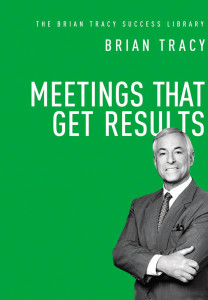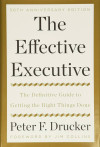Meetings That Get Results
"Meetings That Get Results" addresses the universal business challenge of meeting effectiveness. Tracy presents a systematic approach to planning, conducting, and following up on meetings that actually accomplish their intended outcomes. The book recognizes that meetings consume significant organizational time yet often produce minimal results.
Tracy introduces structured frameworks for different meeting types, from information sharing sessions to complex problem-solving discussions. The book emphasizes that successful meetings result from deliberate planning and skilled facilitation, not chance. Through practical techniques and proven methodologies, leaders learn to transform meetings from time-wasting obligations into productive collaboration tools.
The guide provides actionable strategies for agenda development, participant management, decision-making processes, and accountability systems. Tracy draws from decades of consulting experience to show how proper meeting management directly impacts leadership effectiveness and organizational success.
By reading "Meetings That Get Results," you will:
- Master the fundamentals of meeting preparation and structure: Learn to design meetings with clear purposes, focused agendas, and measurable outcomes that eliminate wasted time and confusion.
- Develop skills for facilitating different meeting types: Practice running information sharing sessions, problem-solving discussions, and decision-making meetings using proven frameworks that keep participants engaged and productive.
- Build decision-making and accountability systems: Create processes that move from discussion to action, with clear ownership assignments and follow-up mechanisms that ensure implementation.
- Transform your leadership presence: Establish yourself as an effective meeting leader who can guide teams through complex challenges and build consensus around important decisions.
Books to Follow
- "Death by Meeting" by Patrick Lencioni: Provides a complementary perspective on meeting dysfunction and introduces innovative meeting formats. While Tracy focuses on systematic execution, Lencioni addresses the emotional and structural problems that make meetings ineffective. The book offers the "meeting advantage" framework that distinguishes between different types of meetings and their specific purposes.
- "Crucial Conversations" by Kerry Patterson, Joseph Grenny, Ron McMillan, and Al Switzler: Develops the communication skills essential for handling difficult topics in meetings. Tracy's frameworks provide structure, while this book teaches the interpersonal skills needed when meetings involve high stakes, opposing opinions, and strong emotions.
- "Getting Things Done" by David Allen: Offers personal productivity systems that complement meeting effectiveness. Allen's methods help individuals prepare for meetings, track commitments made during meetings, and integrate meeting outcomes into their personal workflow systems.
- "The Surprising Science of Meetings" by Steven Rogelberg: Brings a research-based lens to meeting effectiveness, grounding common practices in data. While Tracy provides actionable frameworks, Rogelberg reveals evidence-based insights into what actually works in practice, helping leaders cut waste and increase engagement.
- "Facilitator’s Guide to Participatory Decision-Making" by Sam Kaner: Expands on facilitation skills that ensure meetings are not just efficient but inclusive and collaborative. Tracy emphasizes structure and results, while Kaner provides tools for drawing out diverse voices and building consensus around complex decisions.
Meeting Purpose Drives Everything
Every meeting must have a clear, specific purpose that can be stated in 25 words or less. If you cannot articulate the meeting’s purpose concisely, the meeting will likely be ineffective. This principle forces leaders to think critically about whether a meeting is necessary and helps participants understand their role and expected contributions.
The 70% Delegation Rule
If someone else can perform a task at 70% of your capability, delegate it. This principle applies to both meeting leadership and the work discussed in meetings. Leaders should focus their time on activities that only they can do while empowering team members to handle routine tasks and decisions.
First Five Minutes Set the Tone
The opening moments of any meeting establish pace, expectations, and engagement levels for the entire session. Start with clear statements about purpose, objectives, and expected outcomes. These critical minutes determine whether participants will be engaged contributors or passive observers.
Consensus vs. Democratic Decision-Making
Effective meetings distinguish between gathering input and making decisions. While everyone should be heard to reduce pushback, final decisions require clear ownership rather than democratic voting. The goal is commitment to implementation, not universal agreement with every detail.
Problem Definition Before Solution Generation
Most problem-solving meetings fail because participants jump to solutions without adequately defining the challenge. Always seek multiple perspectives on problem definition and be concerned when only one definition emerges. Different problem definitions often lead to completely different solutions.
Agenda Organization by Priority
Structure meeting agendas with the most important topics first, when participant energy and attention are highest. This approach ensures critical decisions receive proper focus rather than being rushed at the end when people are mentally fatigued or need to leave for other commitments.
Action Orientation and Follow-Through
Meetings without clear action items and accountability become discussion forums rather than decision-making tools. Assign specific owners for each action item and distribute meeting notes within 24 hours to maintain momentum and ensure follow-through on commitments.
Q: How can I tell if a meeting is actually necessary?
A: Ask yourself what would happen if the meeting didn’t occur at all. If the answer is “nothing significant” or if the objective can be accomplished through email, phone calls, or one-on-one conversations, skip the meeting. Only schedule meetings when collective discussion, decision-making, or problem-solving is required.
Q: What’s the biggest mistake people make when running meetings?
A: Failing to establish clear purpose and structure in the first five minutes. Most meetings drift aimlessly because the leader hasn’t communicated specific objectives, expected outcomes, or participant roles. Without this foundation, even well-intentioned meetings become inefficient time consumers.
Q: How do you handle dominant personalities who take over meetings?
A: Use structured formats and clear time boundaries for each agenda item. Acknowledge contributions briefly and redirect to other participants by asking specific individuals for their input. The key is maintaining control of the agenda while ensuring all relevant voices are heard.
Q: When should you use different types of meetings?
A: Information sharing meetings work for updates and announcements, problem-solving meetings focus on specific challenges requiring solutions, and decision-making meetings aim to reach conclusions and assign actions. Most ineffective meetings try to accomplish multiple types simultaneously without proper structure.
Q: How do you get people to actually follow through on meeting commitments?
A: Create clear accountability by assigning specific owners to each action item, setting deadlines, and establishing check-in mechanisms. Distribute meeting notes within 24 hours that clearly outline who committed to what by when. Follow up consistently on commitments in subsequent meetings.
Q: What’s the difference between consensus and agreement in meetings?
A: Consensus means everyone commits to support the decision and its implementation, even if they don’t personally agree with every aspect. Agreement means everyone thinks the decision is correct. Consensus is often more practical and achievable than universal agreement while still ensuring team alignment.
Q: How can you prevent groupthink in problem-solving meetings?
A: Actively seek diverse perspectives on problem definition before discussing solutions. Encourage healthy conflict by asking for alternative viewpoints and potential risks. Use structured techniques like Edward de Bono’s thinking hats to ensure problems are examined from multiple angles.
Q: What should you do when meetings consistently run over time?
A: Start with better agenda planning that allocates specific time blocks for each topic. Begin and end meetings on schedule regardless of late arrivals. Consider scheduling 50-minute meetings instead of full hours to build in transition time. Most importantly, cut off discussions that exceed their allocated time and schedule follow-up sessions if needed.
- When stepping into your first management role: You’re suddenly responsible for running team meetings and cross-functional discussions. The book provides essential frameworks for establishing credibility and driving results through structured meeting management.
- During organizational growth or restructuring: Your company is expanding rapidly or undergoing significant changes, creating a need for better coordination and communication. Tracy’s methods help maintain alignment and decision-making effectiveness as complexity increases.
- When meetings feel unproductive or endless: You’re spending significant time in meetings that seem to accomplish little, or you’re running meetings that participants view as time-wasting. The book provides diagnostic tools and systematic solutions for common meeting problems.
- Before taking on cross-functional leadership responsibilities: You need to coordinate work across departments or lead initiatives involving multiple stakeholders. The book’s frameworks help you facilitate productive discussions between people with different perspectives and priorities.

Your support helps me maintain and improve the book recommendations for everyone.



